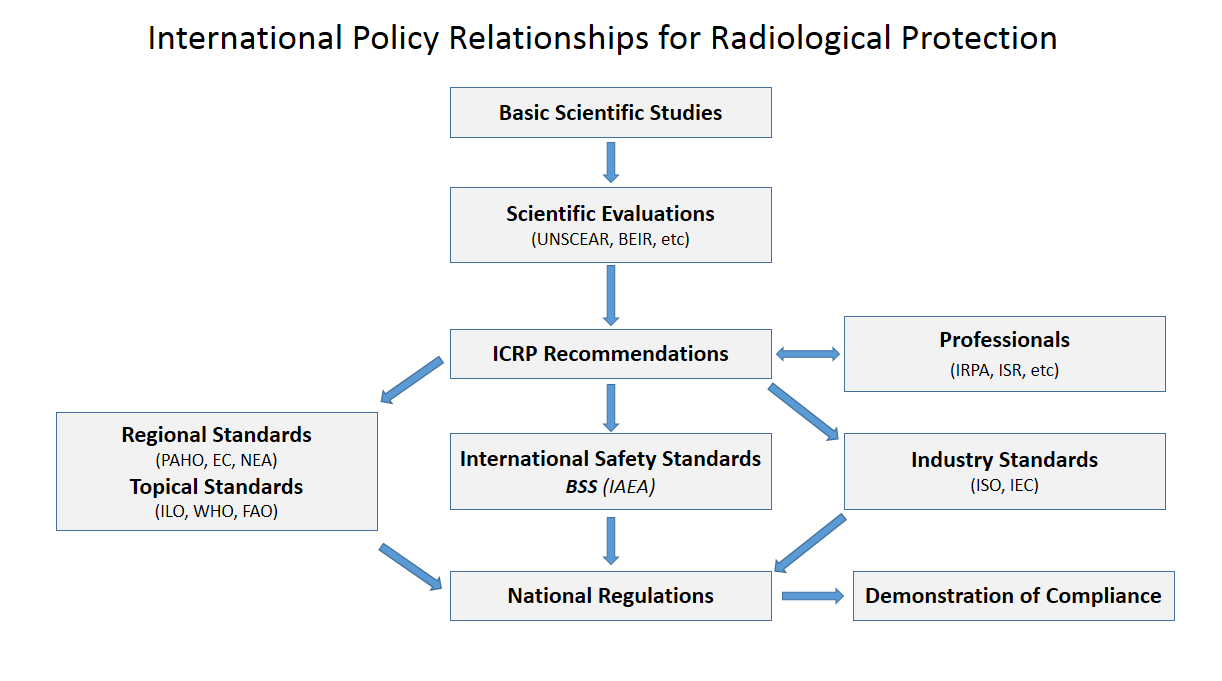|
ALARA
As low as reasonably practicable (ALARP), or as low as reasonably achievable (ALARA), is a principle in the regulation and management of safety-critical and safety-involved systems. The principle is that the residual risk shall be reduced as far as reasonably practicable. In UK and NZ Health and safety law, it is equivalent to so far as is reasonably practicable (SFAIRP). In the US, ALARA is used in the regulation of radiation risks. For a risk to be ALARP, it must be possible to demonstrate that the cost involved in reducing the risk further would be disproportionate to the benefit gained. Factors Determining that a risk has been reduced to ALARP involves an assessment of the risk and costs involved in taking measures to avoid that risk, and a comparison of the two according to cost–benefit analysis (CBA). In this context, risk is the combination of the frequency (likelihood) and the consequence of a specified hazardous event. Several factors are likely to be considered whe ... [...More Info...] [...Related Items...] OR: [Wikipedia] [Google] [Baidu] |
Radiation Protection
Radiation protection, also known as radiological protection, is defined by the International Atomic Energy Agency (IAEA) as "The protection of people from harmful effects of exposure to ionizing radiation, and the means for achieving this". Exposure can be from a source of radiation external to the human body or due to internal irradiation caused by the ingestion of radioactive contamination. Ionizing radiation is widely used in industry and medicine, and can present a significant health hazard by causing microscopic damage to living tissue. There are two main categories of ionizing radiation health effects. At high exposures, it can cause "tissue" effects, also called "deterministic" effects due to the certainty of them happening, conventionally indicated by the unit Gray (unit), gray and resulting in acute radiation syndrome. For low level exposures there can be statistically elevated risks of radiation-induced cancer, called "stochastic effects" due to the uncertainty of them ha ... [...More Info...] [...Related Items...] OR: [Wikipedia] [Google] [Baidu] |
Safety-critical
A safety-critical system or life-critical system is a system whose failure or malfunction may result in one (or more) of the following outcomes: * death or serious injury to people * loss or severe damage to equipment/property * environmental harm A safety-related system (or sometimes safety-involved system) comprises everything (hardware, software, and human aspects) needed to perform one or more safety functions, in which failure would cause a significant increase in the safety risk for the people or environment involved. Safety-related systems are those that do not have full responsibility for controlling hazards such as loss of life, severe injury or severe environmental degradation, environmental damage. The malfunction of a safety-involved system would only be that hazardous in conjunction with the failure of other systems or human error. Some safety organizations provide guidance on safety-related systems, for example the Health and Safety Executive in the United Kingdom ... [...More Info...] [...Related Items...] OR: [Wikipedia] [Google] [Baidu] |
Safety
Safety is the state of being protected from harm or other danger. Safety can also refer to the control of recognized hazards in order to achieve an acceptable level of risk. Meanings The word 'safety' entered the English language in the 14th century. It is derived from Latin , meaning uninjured, in good health, safe. There are two slightly different meanings of "safety". For example, " home safety" may indicate a building's ability to protect against external harm events (such as weather, home invasion, etc.), or may indicate that its internal installations (such as appliances, stairs, etc.) are safe (not dangerous or harmful) for its inhabitants. Discussions of safety often include mention of related terms. Security is such a term. With time the definitions between these two have often become interchanged, equated, and frequently appear juxtaposed in the same sentence. Readers are left to conclude whether they comprise a redundancy. This confuses the uniqueness that ... [...More Info...] [...Related Items...] OR: [Wikipedia] [Google] [Baidu] |
Ratchet Effect
The ratchet effect is a concept in sociology and economics illustrating the difficulty with reversing a course of action once a specific thing has occurred, analogous with the mechanical ratchet (device), ratchet that allows movement in one direction and seizes or tightens in the opposite. The concept has been applied to multiple fields of study and is related to the phenomena of scope creep, mission creep, and feature creep. Background The ratchet effect first came to light in Alan T. Peacock, Alan Peacock and Jack Wiseman (economist), Jack Wiseman's 1961 report "The Growth of Public Expenditure in the United Kingdom." Peacock and Wiseman found that public spending increases like a ratchet following periods of crisis. The term was later expanded upon by American historian Robert Higgs in the 1987 book ''Crisis and Leviathan,'' highlighting Peacock and Wiseman's research as it relates to governments experiencing difficulty in Rollback (legislation), rolling back huge bureaucra ... [...More Info...] [...Related Items...] OR: [Wikipedia] [Google] [Baidu] |
Principal–agent Problem
The principal–agent problem refers to the conflict in interests and priorities that arises when one person or entity (the " agent") takes actions on behalf of another person or entity (the " principal"). The problem worsens when there is a greater discrepancy of interests and information between the principal and agent, as well as when the principal lacks the means to punish the agent. The deviation from the principal's interest by the agent is called " agency costs".''Pay Without Performance'', Lucian Bebchuk and Jesse Fried, Harvard University Press 2004preface and introduction) Common examples of this relationship include corporate management (agent) and shareholders (principal), elected officials (agent) and citizens (principal), or brokers (agent) and markets (buyers and sellers, principals). In all these cases, the principal has to be concerned with whether the agent is acting in the best interest of the principal. Principal-agent models typically either examine moral ... [...More Info...] [...Related Items...] OR: [Wikipedia] [Google] [Baidu] |
Conflict Of Interest
A conflict of interest (COI) is a situation in which a person or organization is involved in multiple wikt:interest#Noun, interests, financial or otherwise, and serving one interest could involve working against another. Typically, this relates to situations in which the personal interest of an individual or organization might adversely affect a duty owed to decision-making, make decisions for the benefit of a third party. An "interest" is a commitment, obligation, duty or goal associated with a specific social role or practice. By definition, a "conflict of interest" occurs if, within a particular decision-making context, an individual is subject to two coexisting interests that are in direct conflict with each other ("competing interests"). This is important because under these circumstances, the decision-making process can be disrupted or compromised, affecting the integrity or reliability of the outcomes. Typically, a conflict of interest arises when an individual occupies tw ... [...More Info...] [...Related Items...] OR: [Wikipedia] [Google] [Baidu] |
Bureaucratic Drift
Bureaucratic drift in American political science is a theory that seeks to explain the tendency for bureaucratic agencies to create policy that deviates from the original mandate. The difference between a bureaucracy's enactment of a law and the legislature's intent is called bureaucratic drift. Legislation is produced by elected officials, but is implemented by unelected bureaucrats, who sometimes act under their own preferences or interests. Bureaucratic drift is often treated as a principal–agent problem, with Congress and the Presidency acting as principals and bureaucracy acting as the agent. The government seeks to control bureaucratic drift in a number of ways, most notably congressional oversight and procedural controls. History Mathew McCubbins, Roger Noll, and Barry Weingast first defined the theory of bureaucratic drift in 1987. They argued that drift is essentially a principal-agent problem that explores "how—or indeed, whether—elected political officials can ... [...More Info...] [...Related Items...] OR: [Wikipedia] [Google] [Baidu] |
Directive 89/391/EEC
Directive 89/391/EEC is a European Union directive with the objective to introducing measures to encourage improvements in the safety and health of workers at work. It is described as a "Framework Directive" for occupational safety and health (OSH) by the European Agency for Safety and Health at Work. History and effect The proposal for the directive was adopted by the European Commission on 24 February 1988 and transmitted to the European Parliament and the Council of the European Union, which consulted the European Economic and Social Committee. The proposal was approved with amendments in the first and second readings by the European Parliament, after which the Commission adopted amended proposals. The Council approved the re-examined proposal on 12 June 1989. Directive 89/391/EEC entered into force on 19 June 1989 and member states were obligated to bring into force laws, regulations and administrative provisions to comply with it by 31 December 1992. The directive was amend ... [...More Info...] [...Related Items...] OR: [Wikipedia] [Google] [Baidu] |
European Commission
The European Commission (EC) is the primary Executive (government), executive arm of the European Union (EU). It operates as a cabinet government, with a number of European Commissioner, members of the Commission (directorial system, informally known as "commissioners") corresponding to two thirds of the number of Member state of the European Union, member states, unless the European Council, acting unanimously, decides to alter this number. The current number of commissioners is 27, including the president. It includes an administrative body of about 32,000 European civil servants. The commission is divided into departments known as Directorate-General, Directorates-General (DGs) that can be likened to departments or Ministry (government department), ministries each headed by a director-general who is responsible to a commissioner. Currently, there is one member per European Union member state, member state, but members are bound by their oath of office to represent the genera ... [...More Info...] [...Related Items...] OR: [Wikipedia] [Google] [Baidu] |
European Court Of Justice
The European Court of Justice (ECJ), officially the Court of Justice (), is the supreme court of the European Union in matters of European Union law. As a part of the Court of Justice of the European Union, it is tasked with interpreting EU law and ensuring its uniform application across all EU member states under Article 263 of the Treaty of the Functioning of the European Union (TFEU). The Court was established in 1952, and is based in Luxembourg. It is composed of one judge per Member State – currently – although it normally hears cases in panels of three, five or fifteen judges. The Court has been led by president Koen Lenaerts since 2015. The ECJ is the highest court of the European Union in matters of Union law, but not national law. It is not possible to appeal against the decisions of national courts in the ECJ, but rather national courts refer questions of EU law to the ECJ. However, it is ultimately for the national court to apply the resulting interpre ... [...More Info...] [...Related Items...] OR: [Wikipedia] [Google] [Baidu] |
Health Canada
Health Canada (HC; )Health Canada is the applied title under the Federal Identity Program; the legal title is Department of Health (). is the Structure of the Canadian federal government#Departments, with subsidiary units, department of the Government of Canada responsible for national health policy. The department itself is also responsible for numerous federal health-related agencies, including the Canadian Food Inspection Agency (CFIA) and the Public Health Agency of Canada (PHAC), among others. These organizations help to ensure compliance with federal law in a variety of Healthcare in Canada, healthcare, Agriculture in Canada, agricultural, and Pharmaceutics, pharmaceutical activities. This responsibility also involves extensive collaboration with various other federal- and provincial-level organizations in order to ensure the safety of food, health, and Medication, pharmaceutical products—including the regulation of health research and pharmaceutical manufacturing/Clinical ... [...More Info...] [...Related Items...] OR: [Wikipedia] [Google] [Baidu] |




